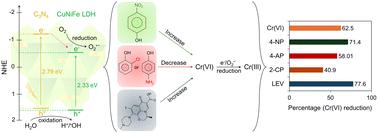有机物的氧化还原性质调节多污染物光催化:利用CuNiFe LDH/C3N4异质结构对有机物进行Cr(vi)还原和降解的研究
IF 4.2
3区 化学
Q2 CHEMISTRY, PHYSICAL
引用次数: 0
摘要
光催化在分解有机化合物和还原重金属方面具有很高的氧化还原活性;然而,以前的研究主要集中在增强这些效果或同时处理几种污染物上,往往忽略了污染物的化学性质和电子行为对其性能的影响。本研究使用CuNiFe层状双氢氧化物/C3N4复合材料来研究不同有机污染物(4-硝基酚(4-NP)、2-氯酚(2-CP)、4-氨基酚(4-AP)和左氧氟沙星(LEV))对Cr(VI)光还原的影响,反之亦然。我们的测量表明,含有吸电子基团的酚类化合物的Cr(VI)还原率从62.5%增加到71.45%,表明电子转移增强。而4-AP和2-CP则分别降低了58%和41%,这是由于它们的供电子取代基的诱导作用和离域效应,调节了氧化还原活性位点的电子密度,抑制了总活性。4-NP、2-CP、LEV和4-AP的光催化降解率分别为59.15%、57.9%、63.01%和51.76%。在Cr(VI)存在的情况下,4-NP的去除率下降到19.01%(竞争相互作用),而2-CP、LEV和4-AP的去除率分别增加到88.37%、68.66%和64.03%(协同作用),表明有明显的氧化还原调节作用。这些发现强调了了解污染物-光催化剂相互作用对优化多污染物废水处理系统的重要性。本文章由计算机程序翻译,如有差异,请以英文原文为准。

Redox nature of organics modulates multi-pollutant photocatalysis: study of Cr(vi) reduction and degradation of organics with CuNiFe LDH/C3N4 Heterostructures
Photocatalysis has demonstrated high redox activity in decomposing organic compounds and reducing heavy metals; however, previous studies have focused primarily on enhancing these effects or treating a few pollutants simultaneously, often overlooking the impact of the chemical nature and electronic behavior of the pollutants on their performance. This study uses a CuNiFe layered double hydroxide/C3N4 composite to examine how different organic pollutants (4-nitrophenol (4-NP), 2-chlorophenol (2-CP), 4-aminophenol (4-AP), and levofloxacin (LEV)) influence Cr(vi) photoreduction and vice versa. Our measurements reveal that Cr(vi) reduction increased from 62.5% to 71.45% with phenolics bearing electron-withdrawing groups, indicating enhanced electron transfer. In contrast, it decreased to 58% and 41% with 4-AP and 2-CP, respectively, due to the inductive effects of their electron-donating substituents and delocalization effects, which modulate the electron density at redox-active sites and suppress overall activity. Individually, 4-NP, 2-CP, LEV, and 4-AP showed photocatalytic degradation rates of 59.15%, 57.9%, 63.01%, and 51.76%, respectively. In the presence of Cr(vi), 4-NP degradation dropped to 19.01% (competitive interaction), while 2-CP, LEV, and 4-AP removal increased to 88.37%, 68.66%, and 64.03%, respectively (synergistic effects), indicating clear redox modulation. These findings highlight the importance of understanding pollutant–photocatalyst interactions to optimize systems for multi-pollutant wastewater treatment.
求助全文
通过发布文献求助,成功后即可免费获取论文全文。
去求助
来源期刊

Catalysis Science & Technology
CHEMISTRY, PHYSICAL-
CiteScore
8.70
自引率
6.00%
发文量
587
审稿时长
1.5 months
期刊介绍:
A multidisciplinary journal focusing on cutting edge research across all fundamental science and technological aspects of catalysis.
Editor-in-chief: Bert Weckhuysen
Impact factor: 5.0
Time to first decision (peer reviewed only): 31 days
 求助内容:
求助内容: 应助结果提醒方式:
应助结果提醒方式:


